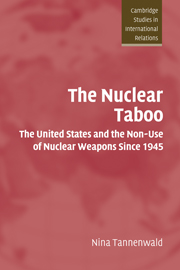Book contents
- Frontmatter
- Contents
- Preface
- List of abbreviations
- 1 Introduction: the tradition of nuclear non-use
- 2 Explaining non-use
- 3 Hiroshima and the origins of the nuclear taboo
- 4 The Korean War: the emerging taboo
- 5 The rise of the nuclear taboo, 1953–1960
- 6 Nuclear weapons and the Vietnam War
- 7 Institutionalizing the taboo, 1960–1989
- 8 The 1991 Gulf War
- 9 The taboo in the post-Cold War world
- 10 Conclusion: the prospects for the nuclear taboo
- Select bibliography
- Index
- CAMBRIDGE STUDIES IN INTERNATIONAL RELATIONS
2 - Explaining non-use
Published online by Cambridge University Press: 22 September 2009
- Frontmatter
- Contents
- Preface
- List of abbreviations
- 1 Introduction: the tradition of nuclear non-use
- 2 Explaining non-use
- 3 Hiroshima and the origins of the nuclear taboo
- 4 The Korean War: the emerging taboo
- 5 The rise of the nuclear taboo, 1953–1960
- 6 Nuclear weapons and the Vietnam War
- 7 Institutionalizing the taboo, 1960–1989
- 8 The 1991 Gulf War
- 9 The taboo in the post-Cold War world
- 10 Conclusion: the prospects for the nuclear taboo
- Select bibliography
- Index
- CAMBRIDGE STUDIES IN INTERNATIONAL RELATIONS
Summary
The dog did nothing in the night-time. That was the curious incident, remarked Sherlock Holmes.
Sir Arthur Conan Doyle, Silver Blaze (1894)The dominant explanation for why nuclear weapons have remained unused since 1945 is deterrence, an explanation routinely mentioned in almost any text on the role of nuclear weapons during the Cold War. In this chapter I critique this explanation, along with several other competing explanations for the non-use of nuclear weapons, on both theoretical and empirical grounds. I then introduce the taboo argument and outline the role of a nuclear taboo in inhibiting the use of nuclear weapons by the United States since 1945. I lay out a framework for evaluating the influence of the taboo in terms of three effects of norms and three pathways by which norms have effects. I then review the leading theories of norm formation and offer a model of how the nuclear taboo developed.
It is often noted that studying non-events – such as the non-use of nuclear weapons – poses special challenges for analysis. It would seem especially difficult to identify the causes of something that did not happen. Yet the study of important non-occurrences is central to the study of international politics (and social life in general, for that matter). We study why revolutions did not occur in some countries, why the debt crisis of the 1980s did not bring the international monetary system down, why the Cold War did not become a hot war, or why ethnic conflict does not break out in some regions.
- Type
- Chapter
- Information
- The Nuclear TabooThe United States and the Non-Use of Nuclear Weapons Since 1945, pp. 29 - 72Publisher: Cambridge University PressPrint publication year: 2007

